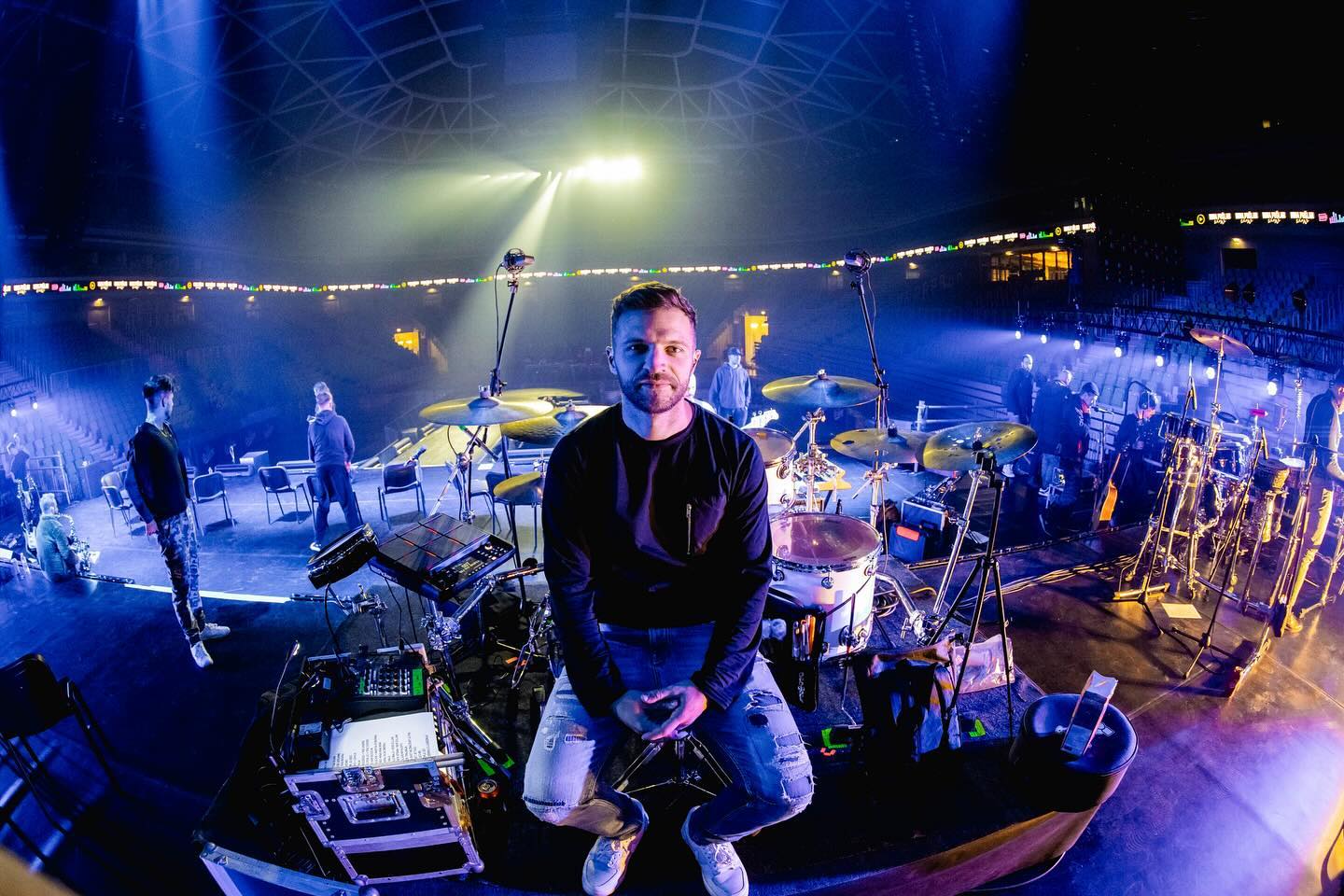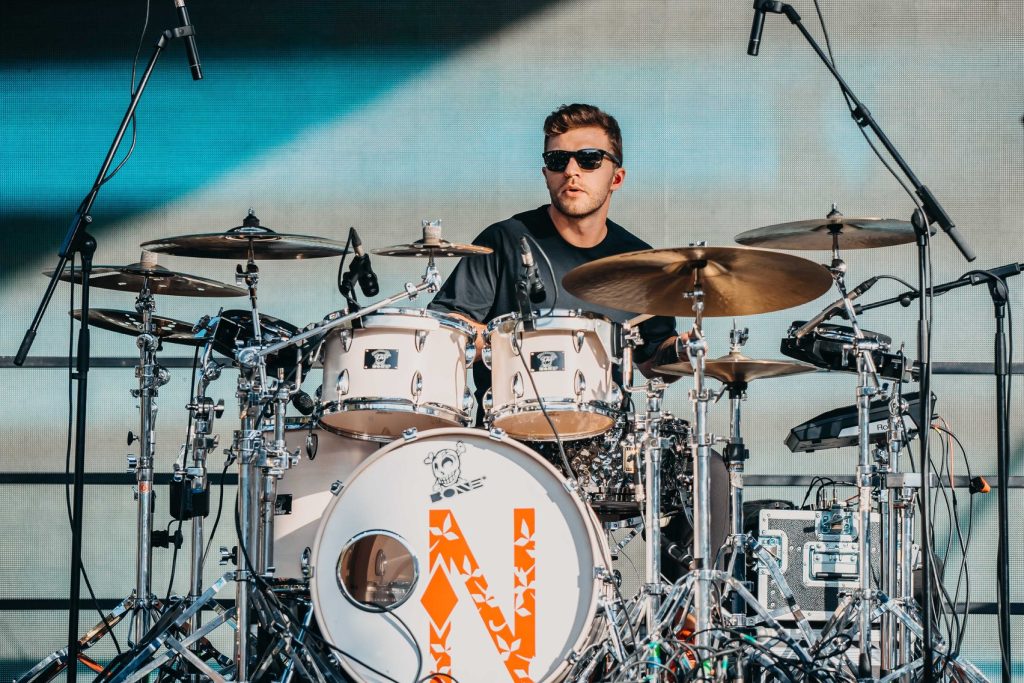Blog
Dorian Granda on finding his sound identity; also with BONE Drums

We recently sat down with Dorian Granda, a well-established drummer in Slovenia, who shared his musical journey, his partnership with BONE, and his take on the contemporary music scene.
What first got you behind the drum kit, and what keeps you there?
Music was a constant in our family. My mom was the director of a music school, so I was exposed to music from a very young age. I started on guitar at seven, then switched to piano, which I studied very seriously until high school. But somewhere in that transition, I started to feel a little bored with the piano. That’s when I started going to shows and discovered the power of the local music scene in Kočevje. My friends and I started a high school band. I was always drawn to the drums, but I’d never had the chance to play them before. Once I finally started, I progressed fast because I already had a solid musical foundation. Since then, I’ve only played drums in all my bands.
What was your biggest initial challenge, and what advice would you give to young drummers coming up?
Honestly, the biggest initial hurdle for a drummer to overcome is achieving hand-foot independence. I still remember how tough it was in the beginning to uncouple my movements so I wasn’t just mirroring the same motion with my hand and foot. Once you get that down, everything just opens up.
My advice to all beginners is: practice! In the beginning, you need to practice more to build the foundation, develop muscles, and train your hands and feet. Initially, I practiced for 3-4 hours, and later increased it to 6 hours. Now I practice very little, not enough (laughs). But back then, I had the drive and energy. Playing sports also helped me a lot—it gave me physical stamina, strength, and muscle. Because swinging sticks on a drum set for six hours is no joke.
I also recommend practicing with a metronome, as it helps you develop precision and accuracy. It’s important, especially at the start, to learn not to be sloppy. The exercises and rhythms you play need to be precise.
It was also really helpful for me to start playing along to the music I was listening to early on. Technique and persistence are essential for getting started, but I recommend starting to play along with a wide variety of music as soon as possible. This gives you a broader perspective and doesn’t limit you to one or two genres.
What music influenced you most at the beginning of your journey?
As a high school band, we played a lot of Red Hot Chili Peppers. Then, I started playing with the ska punk band Sell Out, whose members were 10 to 15 years older than I was. This was my first serious project outside of my local area. We played all over Slovenia—at festivals, venues like Metelkova, and River Splash. I had a lot of creative freedom, and in the studio, when we recorded a few tracks, I came up with the drumming parts myself. This period opened the door for me to play professionally and marked a significant shift in my genre.
How did your partnership with Nejc from BONE start?
I don’t remember exactly how we connected, but I liked the drums he was making. They were made with very high quality. When I compared them to top global brands, I felt—and still maintain—that they are on the same level. I’ve always liked the idea of supporting someone from the local community. To give him support in a way that could help, especially when he was just starting out.
At that time, I was already playing with Nina Pušlar and was more recognizable on the Slovenian scene, and I thought it was great to help him break through. Besides, I genuinely liked everything he showed me. It wasn’t just about his quality and me giving him recognition. I truly believed in what he was doing. And I wanted more people to discover it, to see the effort and the quality, to try them out and be convinced that there was something more to them.

You mentioned you started with Nina Pušlar, so you moved into the pop space. What did you find in BONE drums that worked for your pop sound?
My first BONE set was acrylic. It has a modern sound that is very punchy and open. I was looking for something similar at the time. It can be used for pop, rock, and metal; it’s also great for mainstream pop. The drums can be easily mic’d and set up to stand out. They have a lot of power and attack. I was really satisfied with it. And not to forget—I really liked how it looked. It’s simply beautiful. In addition to the acrylic set, I also had a white ‘birch’ set. That Birch set was very universal, and I could play anything with it.
BONE offers many different sets and wood variations that you can customize to your music, so there’s always something suitable for everyone, even for very demanding players.
How much do you enjoy trying out different materials?
I’m generally not one to switch and try new sets a lot. Once I find something that works for me, sounds good, and gets praised by the guys in the band and our sound engineers, I stick with it. I’m not inclined to constantly change things.
Currently, we have a well-established sound—the whole band has its own sound. If I were to show up to every gig with a different set and different gear, that sound would fall apart. You have to have some consistency, a common thread, for the band to sound cohesive. If you constantly change your equipment as an individual, you also change the band’s sound identity—and in my opinion, that’s not the best approach. As I said, it’s about having a sonic identity. My band and I have built one. We’ve been playing together for a few years and we have our sound. II think that’s the main thing every band and musician has to build—to have a recognizable signature sound.
Of course, experimentation has its place—especially in smaller groups or jazz projects. There, you can be freer and look for new “colors” in the music you create. However, within an established band, I believe you must build and maintain a distinct sound identity.
But you do use the TRUE Carbon Hybrid snare, so you’re not totally “classic.”
Yes, I really like this combination of wood and carbon for the snare. I recall when BONE launched; it was a game-changer—a massive innovation with a high-quality sound. It’s a very light drum; when you hold it, it feels like you’re holding nothing. I use it frequently because it’s versatile and suitable for all genres.
In your opinion, where do electronic drums fit in?
In my opinion, they belong in a living room or maybe in a studio. You can’t replace a real instrument or physical wood. Personally, I will always use acoustic drums because there’s no comparison. Every drummer has their own special ‘touch’ that can only be transferred 100% through an acoustic instrument.
If someone were to call you for a recording session, what kind of project would be the right fit?
They definitely wouldn’t call me for jazz—I know that already, as I’ve never focused on it much. I think they would call me for a pop or mainstream track, possibly incorporating electronic elements. In addition to my acoustic set, I’ve been using electronic sounds and pads for many years. With this, I aim to incorporate new sounds and ‘claps’ to bridge the studio album sound to a live concert. Sometimes, we need to combine the natural microphone sound with an added studio effect. And when that blends well, you get that full, authentic sound that works on stage.
And a final thought…
Over the last year, I’ve started looking at the entire picture more, not just from a musical perspective. I’m more and more interested in everything that surrounds the music: the lights, the venue, the setup, the entire performance. I no longer see a concert just as a musical performance, but as an event, as a whole.
This mindset comes primarily from working with Nina—her vision for the stage, the audience, and the experience is what drives our collaboration. As a team, we have her back completely, and together we’re executing projects we’re incredibly proud of. The recent 20th-anniversary project for her music career is a perfect example.
Today, when someone pays 50, 70, or 100 euros for a ticket, we believe it’s essential that they receive a truly comprehensive experience. Of course, the musical part must be technically perfect, enjoying quality sound, proper execution, and professional production. But you also have to offer something more. Visual effects, an experience, an atmosphere. You want the concert to appear as if something is truly happening on stage. It should be an experience that stays with a person.

This is the ‘performance’. Not just of an individual, but of the entire event. Today, these are no longer just concerts—they are events. The production is larger, more complex, and more thought-out. And I think we have become known for that—we do a lot of concerts, but at the same time, we think more broadly. We develop concepts and pay attention to what the stage looks like, how the lights are set up, and what the screens show. Everything has its content, its own story. We want to package it in a way that leaves a lasting impression.
I’ve always been someone who valued performances where you get more live than just a repeat of the album. If I go to a concert, I’ll always prefer to go see something again that really blew me away live, rather than something that just sounds good in the studio. There are musicians who have great recordings, but then something is missing when playing live.
And that’s what’s important to me—that you give more. In a live setting, you should be able to hear and feel that the musician is a master of their instrument, their sound, and their audience. For me, it’s key that the sound at a concert isn’t just an approximation of what we hear on the album, but that the person on stage gives that little something extra. They should be there with energy, with the right instrument, with feeling—and they should add that final touch. To convey passion and emotion. That’s why we go to concerts. For that authentic energy that a recording can never fully capture.

LINKS: Dorian’s Instagram, Nina Pušlar’s Instagram, https://ninapuslar.com/
